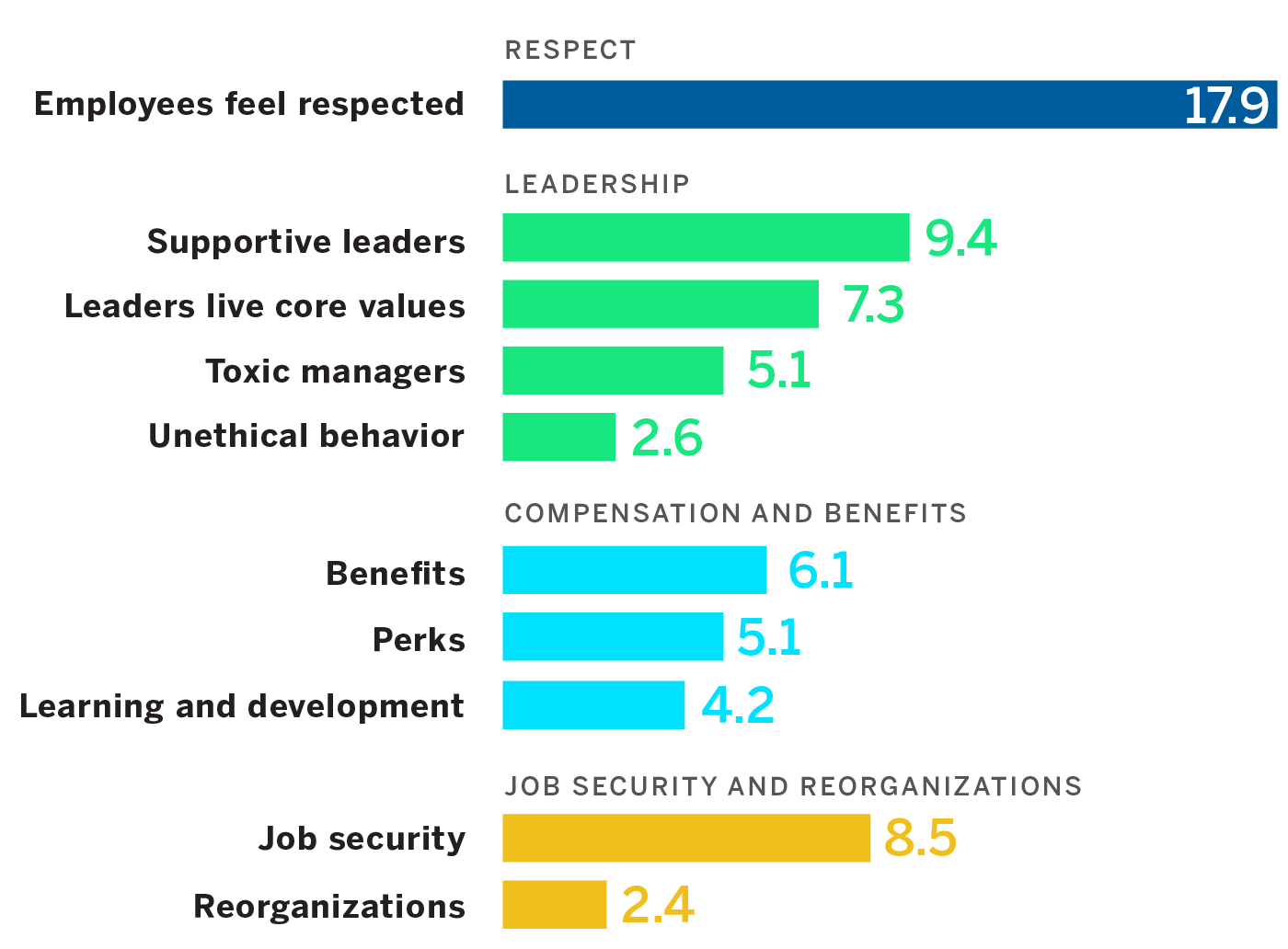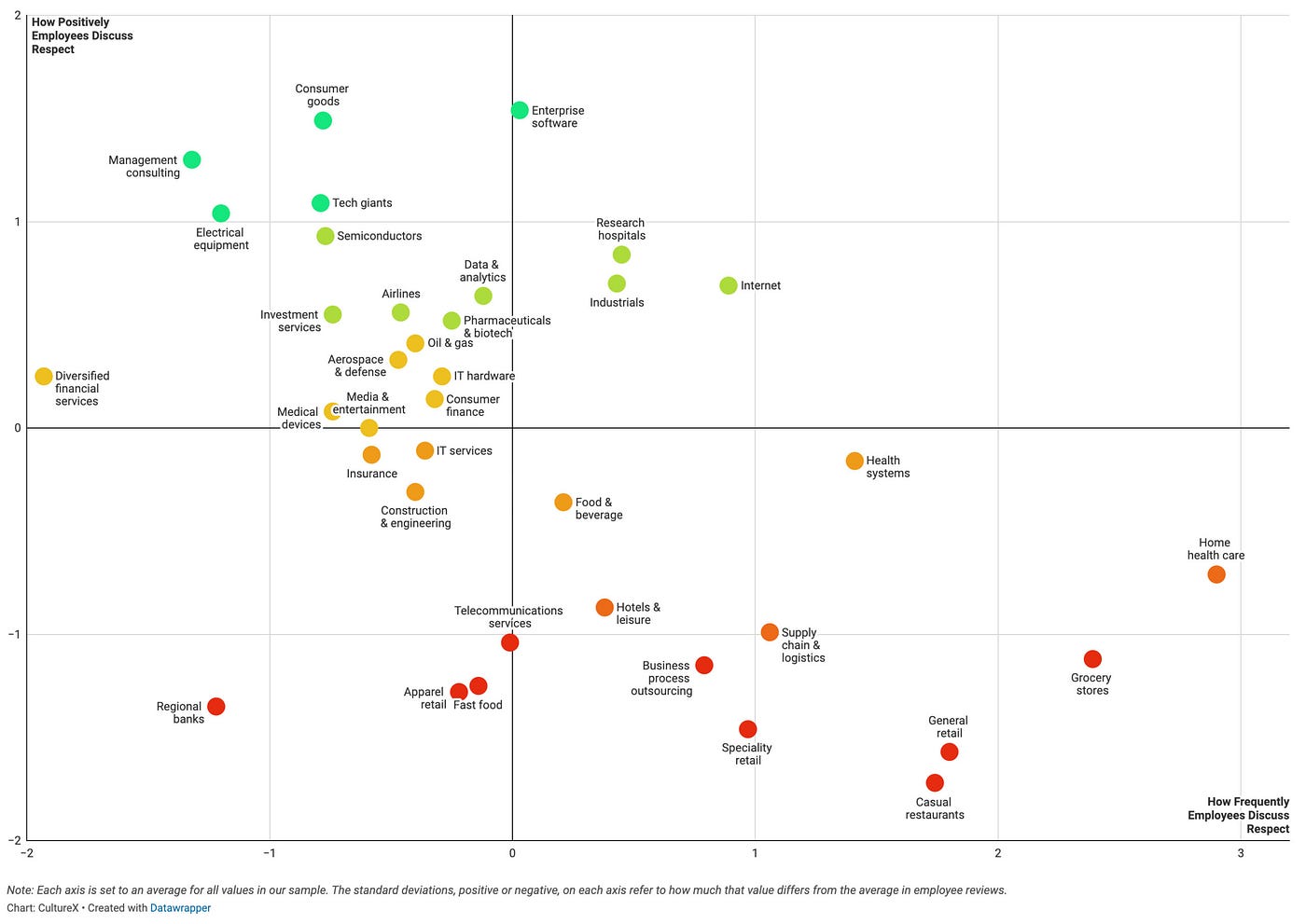MIT Sloan Management Review
Donald Sull and Charles Sull
September 16, 2021
Measuring Culture Research Highlight
Key message:
Knowing what elements of culture matter most to employees can help leaders foster engagement as they transition to a new reality that will include more remote and hybrid work.
Key points:
Corporate Culture Elements Most Important to Employees

In April 2021, nearly 4 million Americans quit their jobs — the highest monthly number ever recorded by the Bureau of Labor Statistics. 1
Employee retention is on the mind of every chief human resources officer, but culture is on the minds of the employees that companies are trying to retain.
In a recent study, nearly two-thirds of employees listed corporate culture among the most important reasons they stay with their current employer — or start looking for another job. 2
Another study found culture is the single best predictor of employee satisfaction, ahead of compensation and work-life balance. 3
Employee retention is on the mind of every chief human resources officer, but culture is on the minds of the employees that companies are trying to retain.
Our multiyear research into corporate culture using Glassdoor data reveals that cultures vary widely in quality in the eyes of their employees.
When people create a review on Glassdoor, they rate their employer’s culture and values on a scale of 1 to 5. We analyzed the average culture score for companies in the Culture 500 — a sample of large organizations, mostly based in the United States.
The typical company has an average culture rating of 3.6, but scores ranged widely — from 2.1 to 4.8 on a 5-point scale.
What distinguishes a good corporate culture from a bad one in the eyes of employees? This is a trickier question than it might appear at first glance.
Most leaders agree in principle that culture matters but have widely divergent views about which elements of culture are most important.
In an earlier study, we identified more than 60 distinct values that companies listed among their official “core values.” 4
Most often, an organization’s official core values signal top executives’ cultural aspirations, rather than reflecting the elements of corporate culture that matter most to employees.
Most often, an organization’s official core values signal top executives’ cultural aspirations, rather than reflecting the elements of corporate culture that matter most to employees.
Which elements of corporate life shape how employees rate culture? To address this question, we analyzed the language workers used to describe their employers. When they complete a Glassdoor review, employees not only rate corporate culture on a 5-point scale, but also describe — in their own words — the pros and cons of working at their organization.
The topics they choose to write about reveal which factors are most salient to them, and sentiment analysis reveals how positively (or negatively) they feel about each topic. (Glassdoor reviews are remarkably balanced between positive and negative observations.)
By analyzing the relationship between their descriptions and rating of culture, we can start to understand what employees are talking about when they talk about culture.
We analyzed a total of 1.4 million employee reviews using the Natural Employee Language Understanding platform developed at CultureX, a company we cofounded. This natural language processing tool is optimized for a single task: understanding employee feedback. Specialization enables us to classify free text with more than 90% accuracy into over 150 topics while picking up business jargon, idioms, acronyms, and slang.
To identify which factors were most important in predicting a company’s overall culture score, we calculated the SHAP (Shapley additive explanations) value for each topic. SHAP values are based on a game-theoretic model developed by Nobel laureate Lloyd Shapley.
This approach analyzes all possible combinations of features in a predictive model to estimate the marginal impact that each feature has on the outcome — in our case, which cultural elements have the biggest impact in predicting a company’s overall culture rating. 5
Before reading on, you may want to pause and consider which aspects of culture you would expect to predict a company’s culture score. The actual results may surprise you.
Topics that you might expect to matter, such as friendly colleagues, flexible schedules, and manageable workloads, were commonly discussed but had little or no impact on a company’s overall culture score. (See “The 10 Elements of Culture That Matter Most to Employees.”)
Topics that you might expect to matter, such as friendly colleagues, flexible schedules, and manageable workloads, were commonly discussed but had little or no impact on a company’s overall culture score.
The 10 Elements of Culture That Matter Most to Employees
- Employees feel respected. Employees are treated with consideration, courtesy, and dignity, and their perspectives are taken seriously.
- Supportive leaders. Leaders help employees do their work, respond to requests, accommodate employees’ individual needs, offer encouragement, and have their backs.
- Leaders live core values. Leaders’ actions are consistent with the organization’s values.
- Toxic managers. Leaders create a poisonous work environment and are described in extremely negative terms.
- Unethical behavior. Managers and employees lack integrity and act in an unethical manner.
- Benefits. Employees’ assessment of all employer-provided benefits.
- Perks. Employees’ assessment of workplace amenities and perks.
- Learning and development. Employees’ assessment of opportunities for formal and informal learning.
- Job security. Perceived job security, including fear of layoffs, offshoring, and automation.
- Reorganizations. How employees view reorganizations, including frequency and quality.
The following chart summarizes the factors that best predict whether employees love (or loathe) their companies. The bars represent each topic’s relative importance in predicting a company’s culture rating. 6 Whether employees feel respected, for example, is 18 times more powerful as a predictor of a company’s culture rating compared with the average topic. We’ve grouped related factors to tease out broader themes that emerge from our analysis.
Corporate Culture Elements Most Important to Employees

Respect
- Employees feel respected. The single best predictor of a company’s culture score is whether employees feel respected at work. Respect is not only the most important factor, it stands head and shoulders above other cultural elements in terms of its importance. Respect is nearly 18 times as important as the typical feature in our model in predicting a company’s overall culture rating, and almost twice as important as the second most predictive factor.
The strong and varied language employees use to describe disrespect suggests how deeply it affects them. Employees describe being demeaned and degraded; viewed as disposable cogs in a wheel or robots; or treated like children, second-class citizens, crap, garbage, dirt, trash, scum, idiots, or cattle.
Respect for employees varied by industry. (See “How Employees Talk About Respect in Their Companies by Industry.”)
- In sectors with a high percentage of professional and technical workers — such as management consulting, enterprise software, and semiconductors — employees were less likely to mention respect compared with all industries (horizontal axis) — and when they did discuss respect, the sentiment was more positive (vertical axis).
- In industries with a large number of front-line employees — including casual restaurants, grocery stores, and specialty retailers — workers were more likely to mention respect and talk about it in negative terms than were employees in other industries.
Employees feel respected. The single best predictor of a company’s culture score is whether employees feel respected at work.
How Employees Talk About Respect in Their Companies by Industry

Industry is not destiny, however, when it comes to a culture of respect. Even in low-scoring sectors like grocery stores, some companies, including Wegmans, Trader Joe’s, and HEB, stand out for their high levels of employee respect and overall strong cultural ratings. In future research in this series, we will explore which elements of culture distinguish companies that create a healthy culture for their front-line employees.
Leadership
Nearly half of employees mention management in their reviews, and their collective assessment of the top leadership team is a particularly strong predictor of a company’s culture rating — four times more important than the average topic and twice as important as discussions of an employee’s immediate boss.
When it comes to corporate culture, it seems, employees assign more of the credit (or blame) to the C-suite than to their direct boss. And this makes sense. The C-suite is responsible for several of the factors that matter most to employees’ assessment of culture — including benefits, learning and development opportunities, job security, and reorganizations.
Our platform categorizes employee feedback into more than 50 distinct ways leaders are described, including whether they are empowering, organized, emotionally stable, or friendly. Among all of these leadership traits, a few stood out as the best predictors of a company’s culture rating.
2. Supportive leaders. Of all the ways employees describe their managers, the most important predictor of a company’s culture score is whether managers support their employees.
Employees describe supportive leaders as helping them do their work, being responsive to requests, accommodating employees’ individual needs, offering encouragement, and having their backs.
Leaders, of course, influence all aspects of culture, but being a source of support for employees is especially critical and is the leadership trait most closely associated with a highly rated culture.
3. Leaders live core values. In an earlier article, we found no correlation, on average, between a company’s official culture and how well core values are practiced on a day-to-day basis. 7
Employees are generally (and rightly) cynical about their employer’s core value statements and don’t expect leaders to live these values. When employees complain that “managers pay lip service to core values” or “a wide gap exists between cultural rhetoric and reality,” their negative sentiment doesn’t ding the company’s culture score much.
When employees praise leaders who “walk the talk” or “practice what they preach,” in contrast, their positive assessment provides a big boost to a company’s culture score. Employees don’t expect leaders to live the core values, but they appreciate it when they do.
4. Toxic managers. At the other end of the spectrum from supportive leaders who live the core values are managers whom employees describe as “horrible,” “poisonous,” or “toxic,” among other extremely negative terms.
Toxic leadership can take many forms, but employees who describe managers as toxic are also more likely to say they are abusive, disrespectful, noninclusive, or unethical.
5. Unethical behavior. This is a particularly dangerous form of toxic management. Integrity is the cornerstone of most organizations’ official culture — nearly two-thirds of all companies list integrity or ethics among their official core values. 8
Integrity also matters to employees — ethical behavior is more than twice as predictive of a company’s culture rating than the average topic.
Pockets of unethical behavior, unfortunately, remain a reality in many organizations. A recent study of managers in brokerage firms found that nearly 10% of them had been involved in financial misconduct, and unethical managers increased the odds that their subordinates would cheat as well. 9
Identifying toxic leaders, digging deeper to understand the context of their behavior, coaching them, or removing them from leadership positions are tangible actions organizations can take to root out people who are undermining corporate culture and potentially exposing the company to reputational or legal risk.
Compensation and Benefits
6. Benefits. When it comes to predicting a company’s culture score, benefits are more than twice as important as compensation. Benefits are important for all employees, but which benefits matter most depend on an employee’s job. Health insurance and benefits are a better predictor of culture rating for front-line workers, while retirement benefits such as 401(k) plans and pensions matter more for white-collar employees.
We are not, of course, arguing that compensation doesn’t matter. Leaders may want to raise compensation, particularly for front-line employees, because it’s the right thing to do — a 2019 study found that 44% of U.S. families did not earn enough to cover their living expenses. 10 Recent research shows that compensation is at least as important as culture in retaining employees, particularly among younger workers. 11 Compensation matters, but it won’t fix a broken culture.
7. Perks. Employees mention nearly 450 different types of perks in their reviews, ranging from arcades to Zumba classes. Among amenities mentioned by more than 50 employees, however, coffee truly is the central perk, with discounted coffee rated positively over 97% of the time. (If you consider less common perks, unlimited meals, onsite breakfast, and free wine have a 100% positive sentiment among employees.)
Employees don’t necessarily expect perks, but they do appreciate them when they’re offered. If a small percentage of employees mention perks, a company’s culture score does not suffer much. When more workers talk about perks, in contrast, companies see a big jump in their culture rating.
Among perks, company-organized social events are a particularly strong predictor of a high culture score. Even when you control for how employees talk about perks in general, social events like team-building exercises, happy hours, and picnics emerge as a reliable predictor of a high culture score. Organizing social events is a promising and relatively low-cost way executives can reinforce corporate culture as employees return to the office.
8. Learning and development. Nearly one-third of all employees mention opportunities for education or personal development in their reviews, making this the third most frequently discussed topic (after management and compensation).
Employees in Culture 500 companies are extremely positive about programs to match or reimburse college tuition and opportunities for exposure to senior executives, particularly early in their careers.
The analysis also shows that learning and development benefits are relatively more important to white-collar workers than front-line employees.
Job Security and Reorganizations
9. Job security. Managers don’t typically think of job security as part of corporate culture — in our earlier study of how companies describe their core values, not one listed job security. Job insecurity, however, weighs heavily on employees’ minds when they assess corporate culture. The larger the percentage of employees who talked about layoffs, outsourcing, or the possibility of getting fired, the lower the company ranked on culture.
10. Reorganizations. Virtually no one has any good things to say about reorganizations. In the Culture 500 sample, employees talked about reorganizations in negative terms 97% of the time. The fewer people who mention reorganizations, the higher a company’s culture score. While you might associate the mention of reorganizations with layoffs and job instability (and there is moderate correlation here), the data reveals that employee concerns on this issue speak to wider strategic issues for companies. When employees mention reorgs, they are much more likely to also discuss the pace of organizational change as too fast, inconsistency in strategy over time, and a lack of clarity about the company’s evolving strategy.
Leaders face a series of challenges while navigating the post-COVID-19 return to work.
They must retain star employees, attract new recruits, and maintain a healthy culture as the workforce adjusts to a new reality that will include more remote and hybrid work. Understanding the elements of culture that matter most to employees can help leaders maintain employee engagement and a vibrant culture as they transition to the new normal.
About the Authors
Donald Sull, is a senior lecturer at the MIT Sloan School of Management and cofounder of CultureX.
Charles Sull, is a cofounder of CultureX.
References
1. I. Ivanova, “People Are Quitting Their Jobs at Record Rates. That’s a Good Thing for the Economy.” CBS News, June 21, 2021, www.cbsnews.com.
2. “Mission & Culture Survey Supplement, 2019,” PDF file (Mill Valley, California: Glassdoor, 2019), www.glassdoor.com. The online survey was conducted by the Harris Poll in June 2019 and completed by over 5,000 adults in the U.S., U.K., France, and Germany.
3. A. Stansell, “ Which Workplace Factors Drive Employee Satisfaction Around the World? “ Glassdoor Economic Research, July 11, 2019, www.glassdoor.com.
4. D. Sull, S. Turconi, and C. Sull, “ When It Comes to Culture, Does Your Company Walk the Talk? “ MIT Sloan Management Review, July 21, 2020, https://sloanreview.mit.edu. We reviewed the websites and annual reports of 689 large, mainly U.S. organizations and found 562 that listed official value statements and identified 62 distinct values listed by at least five companies in our sample.
5. We used an XGBoost model to predict the average culture score for the 599 organizations in our sample. Each model included 158 cultural topics. We split each topic into two features and incidence-measured the percentage of total company reviews that mentioned a specific topic. We sentiment-measured the percentage of reviews mentioning a topic that was positive. If fewer than 15 reviews mentioned a topic in a company, we excluded that topic’s sentiment score from our analysis. Imposing a threshold count to calculate topic-level sentiment resulted in missing values for less-frequently discussed topics, and we chose an XGBoost model because it handles missing values well. The model performed fit the data well, with an adjusted R2 of 0.81 in the testing set. We used SHAP values to estimate each topic’s relative importance in predicting average culture scores. SHAP values quantify the marginal contribution that each feature makes to reducing the model’s error, averaged across all possible combinations of features, to provide an estimate of each feature’s importance in predicting culture scores. For an accessible discussion of SHAP models, see S. M. Lundberg, G. Erion, H. Chen, et al., “ From Local Explanations to Global Understanding With Explainable AI for Trees,” Nature Machine Intelligence 2, no. 1 (January 2020): 56–67.
6. Relative importance is calculated by dividing each topic’s SHAP value by the average SHAP value of all 158 topics included as features in our model.
7. Sull, et al., “When It Comes to Culture, Does Your Company Walk the Talk?”
8. Ibid.
9. Z.T. Kowaleski, A.G. Sutherland, and F.W. Vetter, “ Supervisor Influence on Employee Financial Misconduct,” SSRN, July 20, 2020 (revised May 21, 2021), https://ssrn.com.
10. S. Liu and J. Parilla, “How Family-Sustaining Jobs Can Power an Inclusive Recovery in America’s Regional Economies,” PDF file (Washington, D.C.: Brookings Metropolitan Policy Program, February 2021), www.brookings.edu.
11. M. Smart and A. Chamberlain, “Why Do Workers Quit? The Factors That Predict Employee Turnover,” PDF file (Mill Valley, California: Glassdoor, February 2017), www.glassdoor.com; and B. Zweig and D. Zhao, “Looking for Greener Pastures: What Workplace Factors Drive Attrition?” PDF file (Mill Valley, California: Glassdoor, 2021), www.glassdoor.com.
Originally published at https://sloanreview.mit.edu on September 16, 2021.
TAGS: Corporate Culture; Servant leadership;












